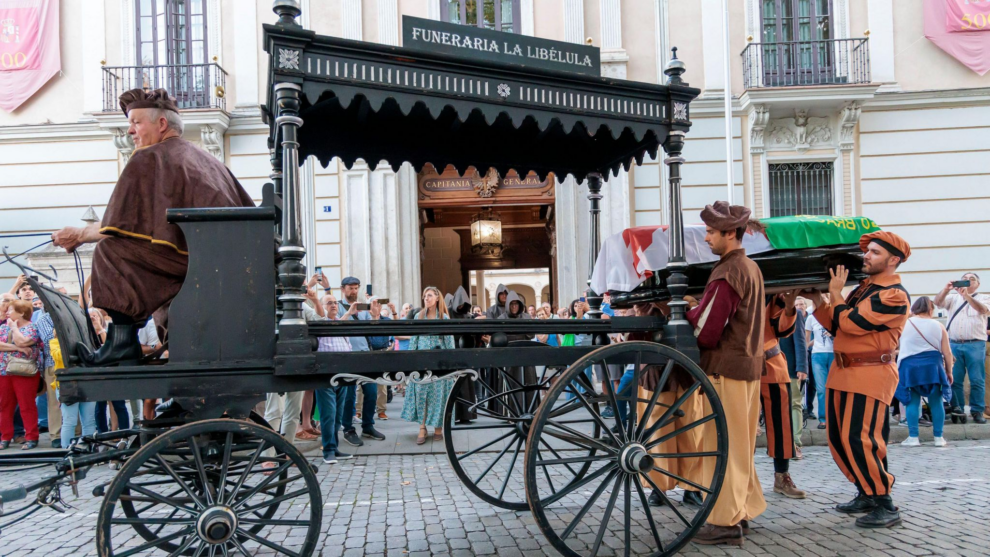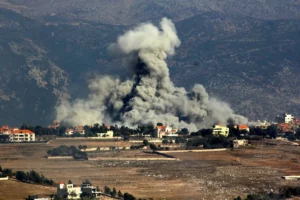An Irish warrior who was once immortalised as a Disney prince has been honoured with another ‘funeral’ in Spain, four centuries after his death.
An empty coffin representing the mortal remains of Red Hugh O’Donnell was paraded through the city of Valladolid in a horse-drawn carriage last week.
Red Hugh was the chieftain of a powerful Irish clan who attempted to drive the English army out of Ireland in the late 16th Century.
He died in Spain in 1602, while on a mission to ask the Spanish king for extra military support for his cause.
Red Hugh was buried in the city of Valladolid, which was then the capital of Spain.
Three years ago, archaeologists dug up a city centre street in an attempt to find the skeletal remains of the red-haired, eight-toed warrior.
Experts are not sure if Hugh’s bones are among the thousands they exhumed, but that has not stopped campaigners from holding elaborate funerals for him.
This year’s event took place on 9 October. Torch bearers in period costume accompanied the cortege as it wound its way through the city’s streets.
“What we were trying to do was to repeat the historical moment of the funeral in Valladolid of Red Hugh,” Carlos Burgos told BBC News NI.
‘A hero’
Mr Burgos is the president of the Hispano-Irish Association which has been at the forefront of a campaign to commemorate Red Hugh and his links to Spain.
He said the Irish chieftain was “someone who was very important, someone who was a hero, and someone who should be respected by us”.
So why does a Spanish city make such a fuss for one Irishman who died so long ago?
Hugh was chieftain of the O’Donnell dynasty and lord of Tyrconnell, a Gaelic kingdom in north-west Ireland which included what is now County Donegal.
As a teenager, he was kidnapped and held hostage in Dublin Castle, because of the threat his family posed to English power in Ireland.
Young Hugh eventually escaped, but suffered severe frostbite as he fled over the mountains and lost a big toe from each foot.
As chieftain, O’Donnell formed alliances with other Irish clans to notch up some significant victories over the English forces of Queen Elizabeth I.
His legacy was romanticised in a Disney movie – the Fighting Prince of Donegal.
“A reckless young rebel rocks an empire” was the tag-line for the 1966 film.
But Hugh’s career ended in disaster at the Battle of Kinsale, which claimed the lives of hundreds of Spanish soldiers who were deployed to support the Irish.
The 30-year-old chieftain died of a mystery illness in a Spanish castle, while trying to convince King Philip to send more troops, weapons and ships.
Mr Burgos says the funerals are in part to remind the public to “how important where the relations between these clans in Ireland and the Spanish monarchy”.
Organisers base their re-enactments on historical records of the real funeral 421 year ago.
“The king of Spain wanted to give him a royal funeral, so that’s what we tried to to remember,” Mr Burgos said.
Valladolid was King Philip’s home city and on his instructions at the time, Red Hugh’s body was taken from the royal palace to a large Franciscan monastery.
The Irishman was then interred in the Chapel of Marvels, a revered site where explorer Christopher Columbus had been buried briefly a century earlier.
Tourist attraction
The monastery was later ruined and the site since redeveloped into a branch of the Spanish high street bank, Santander.
It was at this building in May 2020 that an excavation took place in a bid to find Red Hugh.
The dig was funded by the city council’s Department of Culture and Tourism.
Its manager, Ana Redondo, said at the time if Hugh’s bones were found it would become a discovery of “absolute historical magnitude”.
She added it would put Valladolid on the map for Irish tourists and the millions of Americans with Irish ancestry.
During the dig, archaeologists uncovered the ancient walls of the Chapel of Marvels and recovered 20 almost intact skeletons.
They also found thousands of small, broken and displaced bones within the ruins.
But disappointingly for Red Hugh fans, the skeletons appeared to pre-date O’Donnell’s era “by 100 or even 200 years” according to Mr Burgos.
Analysing the thousands of other bone fragments “would be really, really difficult” he adds.
So for now, campaigners have had to accept that Red Hugh’s whereabouts remains a mystery.
But even without a positive identification, they are still determined to build on the international interest in his fate.
Ireland’s ambassador to Spain was among guests at the re-enactment as speakers reflected on the shared history between the two nations.
A piper played the Irish national anthem on the site of the former chapel, which now bears a plaque commemorating both Red Hugh and Christopher Columbus.
“I listened to the Irish Ambassador, Frank Smyth,” Mr Burgos said.
“He was impressed about the solemnity and the silence – the respect of the people in the street for this man, for this foreigner.”
Although the hunt for Red Hugh has paused for now, campaigners have not given up hope completely.
“It’s not closed 100%, because if any new excavation or investigation appears with a new line of how to try to get the remains, we would follow it,” Mr Burgos added.
Source : BBC

















Add Comment